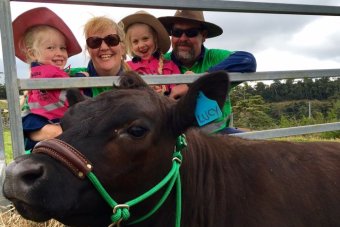Australian Lowline Cattle Producers – Mandy & Kel Tennent
July 17, 2016
Mandy & Kel Tennent with daughters Cassidy & Imogen & Lowline heifer, Lucy
by ABC Rural: Lara Webster 12/7/2016
Good things do come in small packages — that is the message from Australian lowline cattle producers in Tropical North Queensland Mandy and Kel Tennent own and operate a grass-fed beef cattle property at Crediton, about 90 kilometres out of Mackay. They run about 100 head of lowline cattle, with plans to double that number in the future.
The breed is derived from Aberdeen Angus genetics, and the average size is about 110cm in height.
After years of preparation, the couple has finally opened the farm gates to welcome guests onto the farm to gain a better understanding of the lowlines and their paddock to plate production.
Mr Tennent said the small cattle required less inputs than bigger beef breeds such as the brahman, and they boned out well. “Because in their background they have got the Angus and bred from that, the quality of the meat is really, really good,” he said. “You can run more of them on less acreage, and the bone out rate is very high as opposed to a lot of the bigger animals.
“The bigger breeds tend to be getting around 65 per cent [bone out], whereas we tend to be averaging around 70 and anything up to 75 per cent. “The main cuts — eye fillet, rib fillet — they tend to be a bigger percentage of the animal.”
Mrs Tennent said the quality of the meat depended on the quality of the cattle, just like any other beef breed. “Confirmation wise, we like a nice, flat backline, a nice tail set … obviously you are looking at your beef cuts as well, so nice length on the animal so you have plenty of beef, nice depth and width, and a nice rump,” she said.
Small steaks or big steaks?![7587072-3x2-700x467[1]](https://www.lowlinecattleassoc.com.au/wp-content/uploads/2016/07/7587072-3x2-700x4671.jpg)
Mackay chef Ray Manning had never before cooked Australian lowline steak. He was surprised by the size of the beef cuts the small cattle produced, and put together five different dishes featuring the lowline beef.
“I think for the size of the cattle, if you take a look at these rib fillets, we are still really getting close to an average size steak, [that] you would be used to seeing at your butcher shops or supermarkets,” Mr Manning said.
“What I can tell with this beef here is that it has got beautiful fat and a big, thick chunk of marble through the centre, so when I cook these on a hot grill they become beautiful and tender when the fat melts through the steak.”
Are they too cute to eat?
For the 50 or so farm guests who met the small, black cattle, it was difficult to know they would soon be eating some of the herd.
For Leah Fraser, they were just “too cute”. “I always said that I could never eat anything that I know personally, and now I know these personally I don’t think I can eat them,” she said.
For Colin McPherson, there was less attachment and more interest in how the beef came to be on his plate. “It is actually fascinating, the whole process that they have talked about … how they manage their ground to keeping them very, very calm, and then we eat them because of the quality of the meat.”
Linda Clifford has worked in the food industry for a number of years and found it interesting to meet the cattle and see the end result. “A day like today really introduces you to more knowledge … I think everybody has a general knowledge [of how food is produced], but you do not know the intricacies of it,” Ms Clifford said. “To see it from the ground roots is very fascinating.”